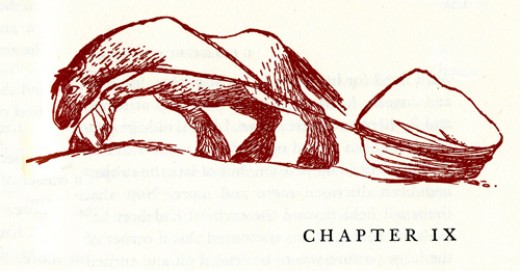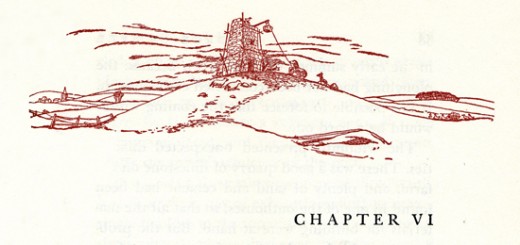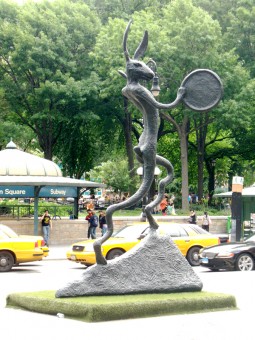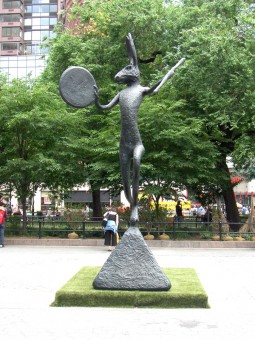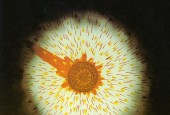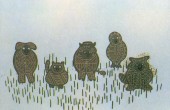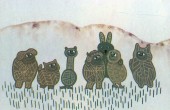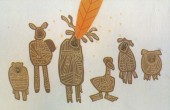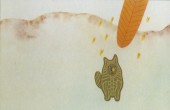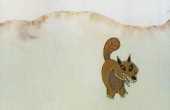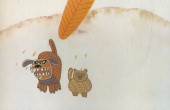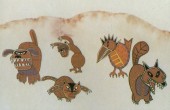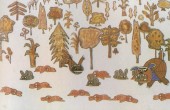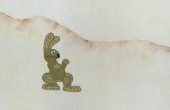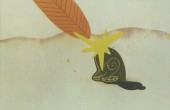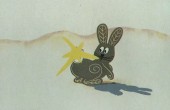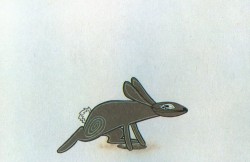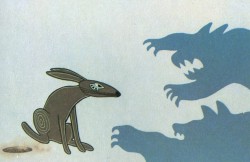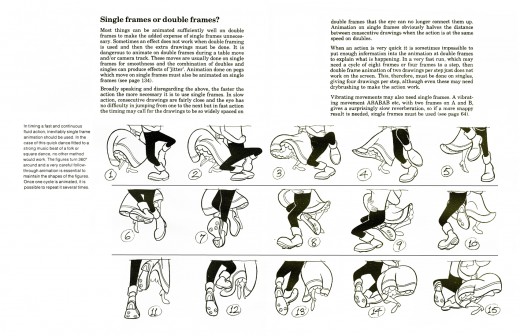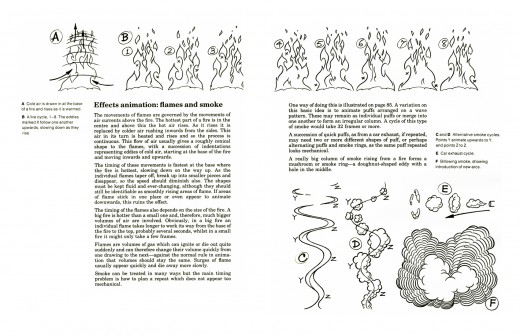Search ResultsFor "animal farm"
Animation Artifacts &Books 03 Jul 2007 08:29 am
Illustrated Animal Farm II
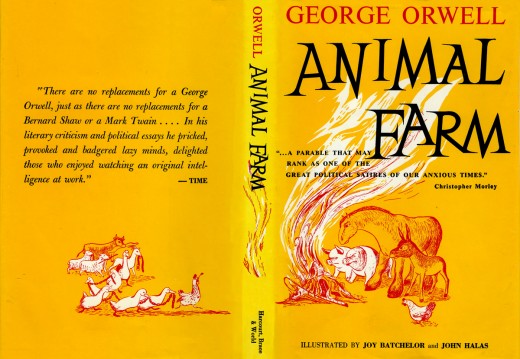 – Here, I continue my posting of the illustrations from a version of George Orwell’s novel, Animal Farm. The drawings are credited to “Joy Batchelor” and “John Halas.” It’s probable that Joy Batchelor did illustrate the book, but I haven’t found evidence as yet. On my last post, Rudy Agresta thought that he remembered Vivien Bachelor discussing her mother’s illustrating it in the book Halas & Batchelor Cartoons. I haven’t found that passage.
– Here, I continue my posting of the illustrations from a version of George Orwell’s novel, Animal Farm. The drawings are credited to “Joy Batchelor” and “John Halas.” It’s probable that Joy Batchelor did illustrate the book, but I haven’t found evidence as yet. On my last post, Rudy Agresta thought that he remembered Vivien Bachelor discussing her mother’s illustrating it in the book Halas & Batchelor Cartoons. I haven’t found that passage.
_______(Click any image to enlarge.)
The animated film was produced by Louis D. Rochemont Associates in 1955 at a studio they set up in Stroud, Gloustershire in England. The studio was formerly the home of the Anson-Dyer company and GB Animation wherein ex-Disney veteran, David Hand, made his short films for Rank.
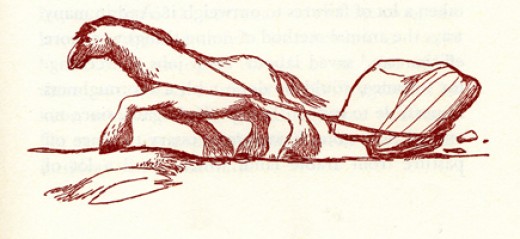
We left off the story with Boxer, the horse, setting an example for the other animals.
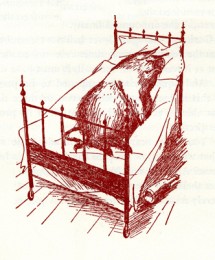
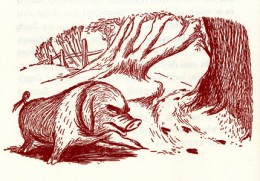
The pigs move into the farmer’s house and become little more than a replacement for “man”.
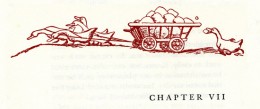
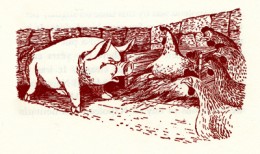
Many animals take the lead of Boxer and try to do their share, while the pigs fight for the lazy leadership.
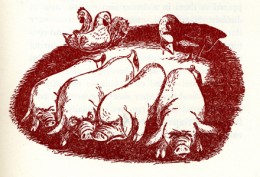

The pigs push Boxer to the limits and use the dogs as their personal guards and force their will on the others.
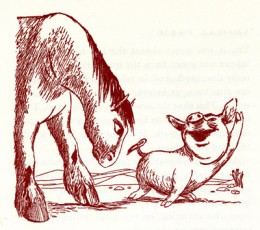
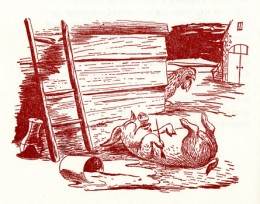
Boxer grows ill as the pigs grow lazier.
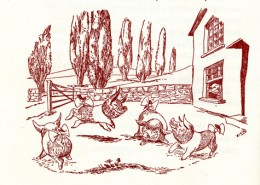
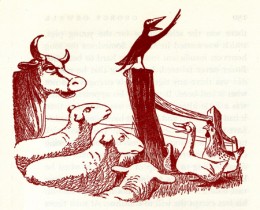
The lazy pigs celebrate their success. Animals hear gossip about the humans planning a charge to take back the farm.
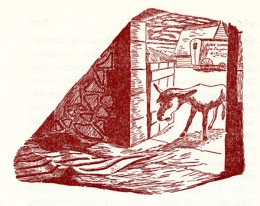
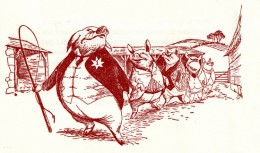
The weakened Boxer, no longer useful to the pigs, is sold for glue.
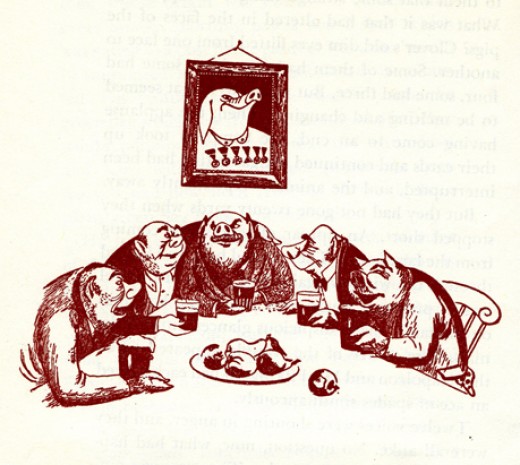
Eventually the humans return, and in some eyes of the animals they blend with the pigs.
The line illustrations do a nice job of representing the film. They’re also quite consistent.
With all the articles and discussions of Ratatouille, there’s an interesting article in today’s NYDaily News by theater critic, Joe Dziemianowicz. He talks about the recent popularity of the dish, ratatouille.
Animation Artifacts &Books 21 Jun 2007 07:32 am
Illustrated Animal Farm I
- When the film Animal Farm was released, a tie-in book was published which republished George Orwell‘s novel with line drawings from the film by “Joy Batchelor and John Halas.” I somehow doubt they did the illustrations, but obviously one person within the studio did do the work. It has the look of a single hand.
There are some 35 spot illustrations, so to showcase them all I’ve decided to break this up into two separate postings. Part II will be up next week.
Here’s the first group:

This is the book’s dustcover._________________________ (Click any image to enlarge.)
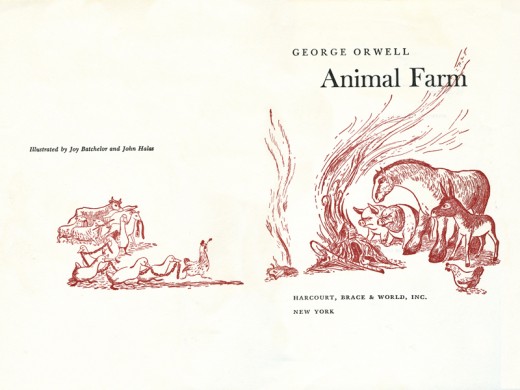
This is the double/title page.
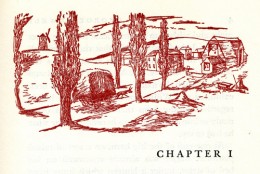
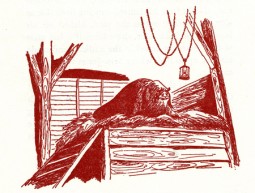
Each chapter has its own heading, and there are usually one to two stills within the body of each chapter.
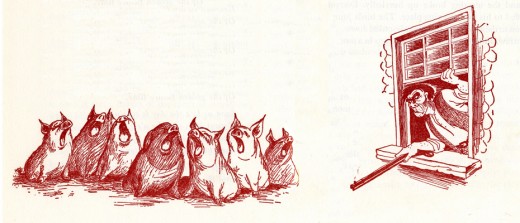
Some of the illustrations, like this one, spread across two pages under the type.
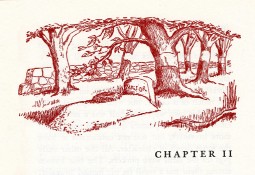
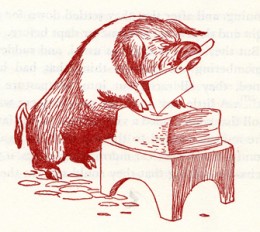
For those of you unfamiliar with this story, it tells the tale of a farm wherein the animals are mistreated.
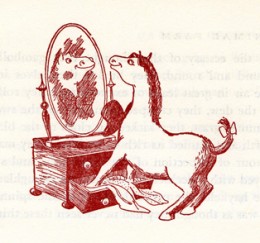
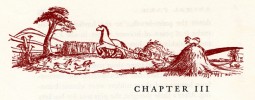
Under the guidance of the pigs, the animals take over the farm and create an animal collective.
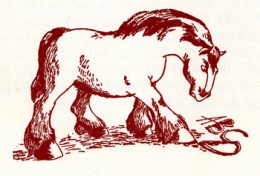
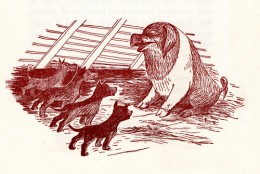
However, the pigs grow lazy and do less of the work as they take charge of the others.
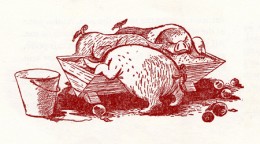
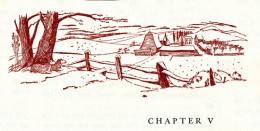
They eat more than their share of the food and mistreat the animals who do the greatest amount of work.
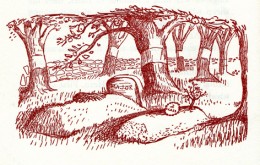
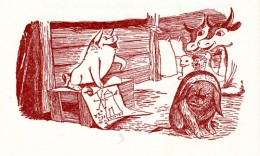
As animals begin to die under the guidance of the lazy pigs, there is some grumbling among the masses.
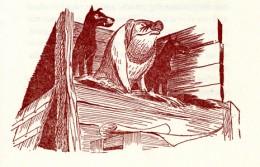
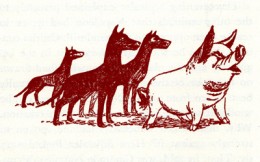
The pigs dominate and rule with a heavy hand.

Boxer, the horse, is the figure of strength and symbolically the real leader of the animals.
You can watch Animal Farm on YouTube by going here.
Art Art &Commentary 10 Jun 2007 10:21 am
Two Statues
- One thing about New York is that there are a lot of statues. Lots of parks filled with lots of statues of late Presidents, generals, soldiers. As we saw in Balto, there’s even a statue of a dog that saved some lives. Not too long ago I posted some steel silver statues of trees as they grew in Madison Square Park. I have a fascination with a lot of the old guy statues that also fill up that park and how they’re all staring at the center – those steel trees.
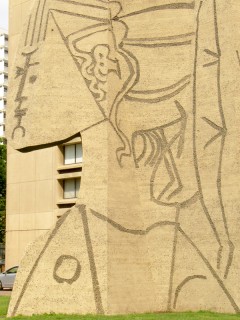 But I thought I’d post some pictures of two statues that fascinate me. One that I see almost daily since moving to the village is the big Picasso statue that graces NYU’s apartment complex on Bleecker Street. Unlike the massive Picasso statue in the center of Chicago, this one is not made of metal. It’s stone. Oddly it almost looks like a statue that was made by an admirer of Picasso’s – it’s almost too Picasso-like. But there’s a lot I like about it.
But I thought I’d post some pictures of two statues that fascinate me. One that I see almost daily since moving to the village is the big Picasso statue that graces NYU’s apartment complex on Bleecker Street. Unlike the massive Picasso statue in the center of Chicago, this one is not made of metal. It’s stone. Oddly it almost looks like a statue that was made by an admirer of Picasso’s – it’s almost too Picasso-like. But there’s a lot I like about it.
I like how it almost exploits the cubist thing as you walk around the statue the size and shape of the head changes. Angles are everything with this lady. As you move around her things keep changing. It makes me curious to know what it looks like from above (like from the roof of the building behind it.)
The color seems designed to almost perfectly match the buildings that stand around it. (Or maybe the buildings were designed to match the statue.) The engraved lines that shape her face use the shadows they create to make them lighter or darker depending on the overhead light.
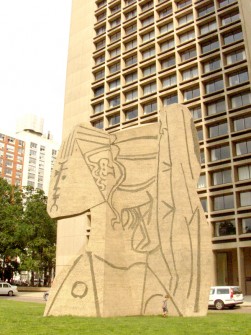
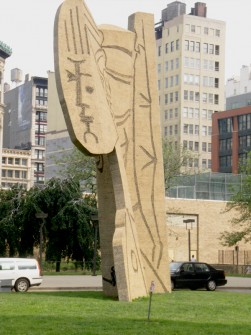
Look how her chin looks completely different as you move around her. The same is true
of the entire statue.
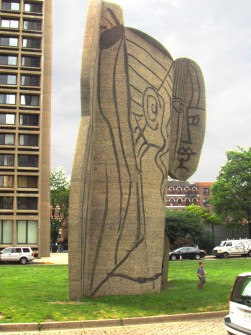
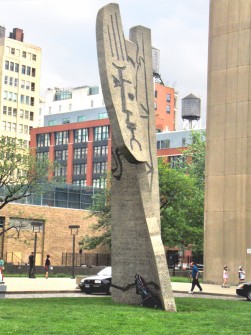
As you turn from back to front the whole statue looks completely different. It’s a great piece.
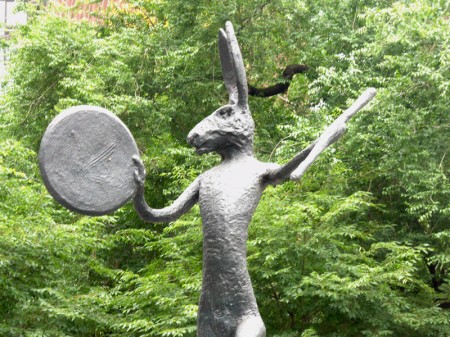
.
Then there’s the rabbit. This piece stands on a small traffic island at the base of Park 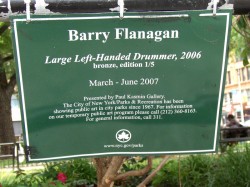 Avenue as it reaches 14th Street. The statue stands at one of the entrances to Union Square Park. If you’re heading to the Farmer’s Market situated within this park, it’s likely you’ll pass this statue.
Avenue as it reaches 14th Street. The statue stands at one of the entrances to Union Square Park. If you’re heading to the Farmer’s Market situated within this park, it’s likely you’ll pass this statue.
The statue is by Barry Flanagan. Apparently he did five of these rabbits (though I haven’t seen any of the others.)
He’s an Irish artist who has done quite a few sculptures of rabbits and other animals. He died in 2005.
(Click on any image to enlarge.)
There’s just such a wide diversity of public art on display; it always stirs me.
What a creative place to live.
Animation Artifacts &Hubley 10 Feb 2007 08:44 am
Watership Down Down Down
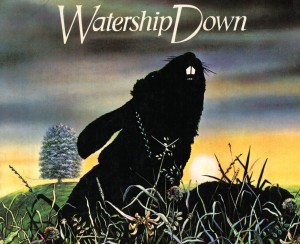 – Yesterday, Mike Barrier expressed some angerl on his site regarding sloppy animation history. He takes to task Stephen Worth and a couple of others.
– Yesterday, Mike Barrier expressed some angerl on his site regarding sloppy animation history. He takes to task Stephen Worth and a couple of others.
I couldn’t agree more with him regarding bad history on the internet. Errors appear everywhere, not just the internet but on these classic dvd’s we buy. (e.g: There’s conflicting information on #3 of the Looney Tunes set’s comment-ary tracks. It’s annoying. Since I particularly trust Barrier‘s accuracy, I went with his version.)
(Click any image to enlarge.)
I give you this information by way of introduction to some probably poor history I’ll present. Everything I offer is guess work. Unlike some others who are overconfident about their guess work, I’m emploring anyone who has conflicting information to let me know so that I can straighten the record and learn the truth, but I do feel somewhat confident.
The subject is John Hubley‘s involvment on the feature Watership Down.
I made some comments a couple of days back about Doonesbury and it prompted a question by David Nethery which started my rambling in response. I decided to add a couple of illustrations, and it’s evolved into this post.
There is no doubt in my mind that Hubley planned and shaped the opening sequence built around aboriginal art. Australian production designer, Luciana Arrighi often gets credit for this. However, I am sure Hubley put it into action and directed it. It’s his style. Perhaps it’s his style by way of Luciana Arrighi, but in the end it came out Hubley‘s.
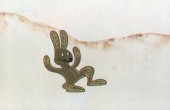
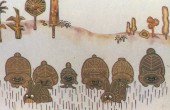
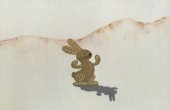
Also obviously his is the guiding spirit of the Black Rabbit of Inle which appears throughout the film particularly after the death of Hazel.
Bill Littlejohn, Phil Duncan, Ruth Kissane, and Barrie Nelson – all Hubley regulars – acted as animator or animation directors on the film. I think they visited the studio in England, but most certainly worked freelance from their homes. A guess – strictly a guess – is that Phil Duncan animated that opening. It feels like his work to me.
I was not in touch with John during this feature or after he had been pushed out of it. At the end of Everybody Rides The Carousel I moved over to Raggedy Ann. Dick Williams had been a hero of mine since the late sixties when I learned of his work. I’d had a number of letters back and forth to his Soho studio, and I contemplated the trip to show him my art. (How much easier everything is with the internet!)
As Carousel wound down, I watched closely as Dick competed for the Raggedy feature. He worked with Tissa David to do a short pencil test of Ann & Andy dancing to a piano score by Joe Raposo. Shamus Culhane was doing the same for Joe Oriolo. The two presentations went solidly Dick’s way, and he got that film. Tissa presented my name to Dick, and I was offered the first staff position on the upcoming feature.
At the same time, John Hubley was offered Watership Down. He had made the comment that he’d like to do the job that Halas & Batchelor had blown with Animal Farm, and he thought this could be the film fo that. This was a very exciting prospect to my ears. However John didn’t want me to go to England. I sure would have followed if he’d asked.
He asked if I would stay in New York and manage his studio there. He thought it might be possible to do some work in New York while he did the film in London. We even negotiated a very meager salary (John was the tightest guy I knew. He’d faced bankruptcy several times and watched his money closely.) Ultimately, watching what was about to happen half a mile away was too enticing for me. I wanted the chance to work with Dick Williams who had already brought on board Art Babbitt, Emery Hawkins, John Kimball, Gerry Chiniquy, Corny Cole and others. My allegiance was more with Tissa by this point, and I made my decision.
So, my analysis of the scenes I see is based solely on my love of Hubley’s work. I’ve inbetweened and inked and colored thousands of Phil Duncan’s drawings and scenes, and I’ve designed for John Hubley knowing full well that every drawing I was to do under him came out looking like a Hubley film. (John was the best artist I’ve ever met, so no one, in my opinion, could match what he could do with the simplest of lines.) I think my speculation on these short scenes in Watership Down is correct. I hope anyone won’t prove me wrong, but there it is.
There’s a very nice piece on the web by Richard Bell about his work in BG’s under Hubley and Martin Rosen.
There’s also an extensive and very insightful piece by Chris Boyce with analyzes the film in depth. He tries hard to separate what might be Hubley’s from Rosen’s.
Animation Artifacts 15 Dec 2006 08:03 am
Harold Whitaker
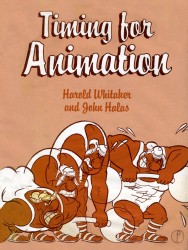
 - Harold Whitaker‘s “Timing For Animation.” is an animation book which I like very much, yet it has, I think, gotten short shrift in most animation circles.
- Harold Whitaker‘s “Timing For Animation.” is an animation book which I like very much, yet it has, I think, gotten short shrift in most animation circles.
The book can still be located on line, and I urge you to go for it. It reads like a hard covered Preston Blair primer, yet the information in it is much more detailed than Blair’s and doesn’t attempt lessons in how to draw. The focus stays solidly on how to animate.
The information is clear and concise with illustrations from HB films that Whitaker animated.
(Click on images to enlarge.)
Whitaker was the key animator at the Halas and Batchelor studio. His work has a looseness to it that stands out from most of the animation in the H&B product. He seems to have started animating during the production of Animal Farm and continued working right up through 1988.
Page by page the book offers what seems like a series of valuable lesson plans for would-be animators. There’s so much in the book, but it’s done in a deceptively simple manner, so it seems as if it’s not quite as thorough as it is.
Here, I’d like to post a couple of pages to give a sample of it for you.
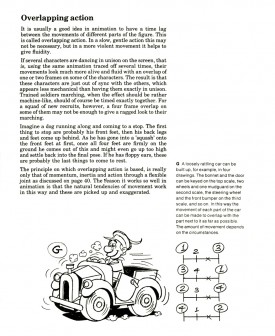
The book is called Timing For Animation for a reason. Timing is the essence of animation, and the book focusses on this topic. There are plenty of examples of production charts, exposure sheets and spacing charts.
There are the usual definitions of “Anticipation” and “Follow-thru.” But there’s also examples of “Timing to suggest Weight and Force;” and a breakdown of how to use “Timing Cycles” and the “Timing of a Walk.”
I like the book and have used it for my classes, when I did teach. I also usually recommend the book when I lecture about animation. If you’re not familiar with it, try to check it out.
Books 17 Aug 2006 07:16 am
More Books
![]()
- Having featured a book from 1940 these past few days, I think it’s time to bring things up to date. There are a couple of books about to be released, and I’d like to make mention of them.
Animated News posts the complete press information for Tony White’s new book, Animation from Pencils to Pixels.
Tony White, of course, was the brilliant animator who rose in Dick Williams’ Soho studio (animating the Pink Panther credits), winning the BAFTA award for his brilliant short, Hokusai.
He also wrote the invaluable animation production book, The Animator’s Workbook. (This is one book I don’t think any potential animator should be without.)
After the brilliant first book, I’m looking forward to his second book. It obviously takes the 2D animator into the digital age – as has Tony White, himself.
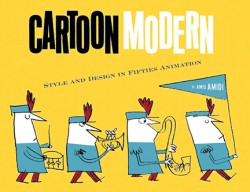 – Everyone knows about the release of Amid Amidi‘s book, Cartoon Modern: Style and Design in 1950s Animation .
– Everyone knows about the release of Amid Amidi‘s book, Cartoon Modern: Style and Design in 1950s Animation .
I’ve already posted several times about it, but that gives you an indication of how much I’m anticipating it. The book is a special event since it’s the first to really highlight the more eccentrically designed animation of the 50′s and early 60′s. This is a point in the era of animation that has been sorely bypassed by most animation historians.
Hopefully this book will help fill the gap. If it’s anything like Amid’s companion site, Cartoon Modern, it’ll be a gem.
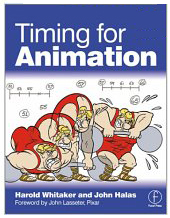 – Finally, I’d like to highlight a slightly older book that’s very much in print, but rarely do you hear anyone promote it. Timing for Animation is a book written by Harold Whitaker. Harold was the principal animator at the Halas & Batchelorstudio. He led animation on Animal Farm and Ruddigore. His style in those films was quite distinctive, and there’s no doubt he was a quiet, unheralded master.
– Finally, I’d like to highlight a slightly older book that’s very much in print, but rarely do you hear anyone promote it. Timing for Animation is a book written by Harold Whitaker. Harold was the principal animator at the Halas & Batchelorstudio. He led animation on Animal Farm and Ruddigore. His style in those films was quite distinctive, and there’s no doubt he was a quiet, unheralded master.
The book is brilliant in that it gives quite a few animation tips in simple, clear language, easily understood. I used it as a primer for my students for the short time I taught animation. I advise you all to at least look at it; you’ll end up buying it if you want to know about animation mechanics.
Commentary &Daily post 04 Aug 2006 09:20 am
Where’s the Beef?
- Amid Amidi has posted an excellent look at fifties animation books on his Cartoon Modern site. He leads us to books and tapes available on the subject. The Art of the era.
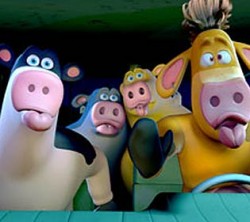 – To get away from Art let’s talk about cleaning up the Barnyard.
– To get away from Art let’s talk about cleaning up the Barnyard.
Here are some of the local reviews for that Nickelodon film; they’re all negative. Too bad.
When you have a live-action auteur like Steve Oedekirk come in to write and direct an “animated feature,” surely you’re on the right track. Why should the director know anything about the craft?
The animals, for the most part, seem to be walking upright, on their hind legs. I guess it’d have been more difficult doing a four-legged animal with motion capture.
I’ve about had it (as Popeye said: Enough is too much!). I’d rather quote a few of the local critics than try to waste my time articulating what I think about it.
Mahola Dargis, NY Times: The udder looks a lot like the base of a plumber’s plunger and the teats look exceptionally friendly, like chubby little fingers waving toodle-oo. They’re so friendly that it’s hard not to stare at them and wonder what would happen if you milked Otis, which proves both distracting and something of a relief, since there isn’t all that much else in this film to think about.
Elizabeth Weitzman, NY Daily News (1 ½ stars): Nothing in this movie makes any sense, especially considering that it’s ultimately geared toward young children. The high-quality animation can’t distract from tragic funeral scenes and frightening fights, let alone racial stereotypes ranging from a feisty Mexican mouse to a sassy black Bessie. Too mature for little kids and much too corny for older siblings and chaperones, “Barnyard” probably should have been put out to pasture long before it made it to the multiplex.
Scott Tobias, The Onion: The truth about farm animals is that no matter how humane the farmer (or how lush the rolling meadows, or how slop-filled the pen), they’re all kept around to produce food products, and eventually, that means death by unnatural causes. Otherwise, it’s not really farming, is it?
An honest children’s tale at least acknowledges that fact, and the classic Charlotte’s Web turned it into a note of great poignancy, because even prize-winning pigs and their eight-legged friends have to come to terms with the inevitable. When a patriarchal cow dies in the hideous new animated film Barnyard, he’s actually buried six feet under with a ceremony and a tombstone—no steak, no rump roast, not even a pile of tripe. It may seem unfair to expect realism from a movie about anthropomorphic party-animals who walk around on their hind legs, but the film crosses the line. What makes them animals? What makes this a farm? What would George Orwell think?
Kyle Smith NY Post (1 ½ stars): ANIMATED FARM TALE UDDERLY UNREDEEMING If you want to punish your kids, send them to bed without dinner. If you want to disturb, frighten and depress them while making sure they fail biology, take them to the animated feature “Barnyard.”
My only real question is: why do all children’s films have to be so cynical and nasty?
Animation Artifacts &Illustration 15 Jan 2006 09:25 am
Animal Farm horses
Dredging Up More Memories:
When I was young, of course, I was under the Disney influence. I can remember with absolute clarity the day I went to see Lady And The Tramp for the first time at my local theater. 1955; I was nine years old. My parents allowed me to go alone, but I had to take and supervise my younger brothers and our cousins. It was another era. 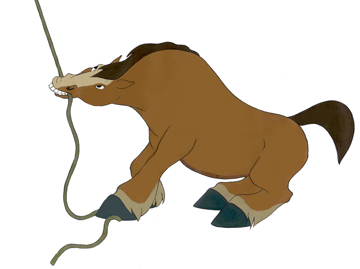
The year that film was completed was also the year Halas and Batchelor‘s Animal Farm was released.
I don’t remember it being released theatrically in the US, but it took another four years for that British film to make it to our local tv programming where I first saw it. I hadn’t read the book, so I was completely unaware of the story. The film was overwhelming, and I was completely taken with Boxer, the horse that represented the strength and will of the farm.
This was different for me – grown-up animation. There was no looking back.
1959 was the same year I found Halas’ Technique of Film Animation in my local library. Now I could read about the making of this unique movie.
It only took another two years for me to be completely dedicated to the films of the Hubleys and another 11 years for me to be working for them. Just before John was to leave for England to direct Watership Down we had a short conversation. I’d brought up Animal Farm as a serious attempt to make an adult film and told him I was looking forward to seeing his work on this film. He then told me that he thought that the bungled job Halas & Batchelor had done on the film was a great regret to him. “What a film that could have made,” were his exact words.
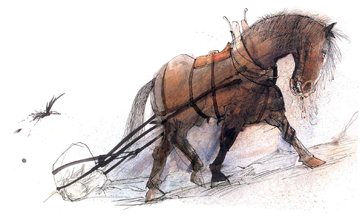 Pretty funny that it was that same year Hubley’s assistant gave me a gift of the Halas book.
Pretty funny that it was that same year Hubley’s assistant gave me a gift of the Halas book.
I thought of all this yesterday after visiting Cartoon Modern and seeing the new links that Amid had put up on his site. He has a great resource there, and I look forward daily to what new items he’ll send our way.
An illustration from Ralph Steadman’s book, “Animal Farm.”
Charles Solomon has a couple of interesting articles in the New York Times today. One is on Miyazaki‘s son who is preparing an animated feature. The second is about the success of non-computer animated features in the race for the Oscars.
